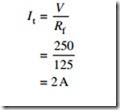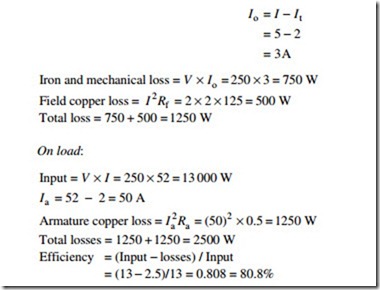DC motors
The development of the DC motor preceded that of the AC motor. Today, even with the preponderance of AC motor applications, notably in traction, the DC motor retains its position due to its unique characteristics.
DC motors are used for applications that require a wide range of torque and good speed control.
Types of DC motors
The basic working principle of DC motors has already been dealt with. This section details the types of DC motors. The different types depend on the method of connection of the armature and the field winding and they are classified as below:
• Separately excited motor
• Series DC motors
• Shunt DC motors
• Compound DC motors.
Separately excited motor
In a separately excited motor, as shown in Figure 4.8, the field supply is provided in a manner other than by an armature supply.
Since the field current is taken from a separate supply, field current is independent of the load.
The flux remains essentially constant and does not affect either the speed or the torque.
These types of motors are not used generally, as they require a separate field supply and also large variations in field current apart from the armature circuit.
Series DC motor
As shown in Figure 4.9, the motor has the armature and field winding connected in series, therefore, its name – series motor. Field winding is made up of a relatively few turns of a large diameter wire so that the field resistance remains low.
In the series-wound DC motor, the field windings are fixed in the stator frame and the armature windings are placed around the rotor. These are connected in series. The current passing through the armature also passes through the field. In a series-wound motor, any increase in the load results in more current passing through the armature and the field windings.
As the increased current strengthens the field, the motor speed decreases.
Conversely, if the load is decreased, the field is weakened and the speed increases. For lighter loads, the speed increase may be excessive and undesirable.
In order to control this, the series-wound DC motors are usually directly connected or geared to the load to prevent runaway.
At times, a series-wound motor designated as a series-shunt wound, is provided with a light shunt field winding, to prevent the dangerously high speeds at light loads. The increase in armature current with the increasing load produces an increased torque, so that the series-wound motor is suited to he avy staring duty. The motor speed can be adjusted with a variable resistance placed in series with the motor, but due to the variation with the load, the speed cannot be maintained at a constant. The series-wound DC motors are used for hoists, cranes, and elevators.
Shunt DC motors
Shunt motors are used in applications where a good speed regulation is required. In the shunt-wound DC motor, as shown in Figure 4.10, the field winding is connected in parallel with the armature winding.
In this type of motor, the field winding has many turns of small diameter wire to keep the resistance high.
The strength of the field is not affected appreciably due to changes in the load. A more or less constant speed is obtainable.
Shunt-wound DC motors are used where a more or less constant speed, a low staring torque, and a light overload on the motor are required.
The shunt-wound motor can also work as an adjustable-speed motor by means of the armature control or field control.
If a variable resistance is placed in the field circuit, the amount of current in the field windings can be controlled and the speed of the motor can be controlled.
As the motor speed increases, the torque decreases proportionately, resulting in an approximately constant horsepower.
If a variable resistance is placed in the armature circuit, the voltage applied to the armature can be reduced, and hence the motor speed can be reduced. With an armature control, speed regulation becomes poorer as the speed is decreased. Since the current in the field remains unchanged, the torque remains constant.
Adjustable-speed shunt-wound motors are used on large machines for boring mills, lathes, planners, etc. These are particularly adapted to spindle drive because of the
constant horse-power characteristic that permits heavy cuts at low speeds and light cuts at high speeds.
Adjustable-voltage shunt-wound motor drive
Due to the requirement of DC power, the application of shunt-wound DC motors has been limited. Extensive use of the shunt-wound motors has been made possible by a combination drive that includes a means of converting AC to DC. A self-contained unit may achieve the conversion of AC to DC. This consists of a separately excited DC generator driven by a constant-speed AC motor, connected to the regular AC supply. An electronic rectifier with suitable controls, connected to the regular AC supply, can also achieve this. The conversion of AC to DC with an electronic rectifier has the advantage of causing no vibrations.
In an adjustable-speed, shunt-wound motor drive, speed control is affected by varying the voltage applied to the armature while supplying a constant voltage to the field.
In addition to providing for the adjustment of the voltage supplied by the converter, to the armature of the shunt-wound motor, the amount of current passing through the motor
field may also be controlled. In fact, a single control may be provided to vary the motor speed, from a minimum base speed, by varying the current flowing through the field. With such control, the motor operates at a constant torque up to the base speed and at constant horsepower above the base speed.
Adjustable-speed shunt-wound motor drives are also called DC-adjustable voltage drives. These drives are used for milling machines, boring mills, lathes, and other industrial applications where wide, step-less speed control, uniform speed under all operating conditions, a constant torque acceleration and adaptability to automatic operational control are required.
Compound-wound motors
These types of motors provide desirable characteristics of both series- and shunt-wound motors. They provide high-starting torque as in a series motor, as well as good speed regulation as in a shunt-wound motor.
In these types of motors, there are two field windings; one is in series with the armature, while the other is in parallel with the armature.
In the compound-wound motor, the speed variation due to load changes is much less than that in the series-wound motor, but greater than that in the shunt-wound motor. The compound-wound motor has greater starting torque than the shunt-wound motor and is able to withstand heavier loads for narrow adjustable-speed range (Figures 4.11 and 4.12).
• DC motors have good starting torque as well as good speed-regulation capabilities.
• Permanent magnet-type DC motors are used for exact positioning of objects
with high-operating torques.
• Series type gives high-starting torque; hence the ability to start with high loads.
• Series motors when operated with no loads can attain high speeds causing harm to motor.
• Shunt-type motors have good speed regulation.
• Direction reversal of DC motor can be done by changing the leads of the armature or the field.
• Speed of DC motor changes either by changing armature voltage or field current.
• If armature voltage is increased, speed increases till base speed and vice versa.
• Similarly, speed can be increased above base speed, by decreasing field current.
• In shunt motors torque is proportional to armature current.
• In series motors torque is proportional to square of armature current.
Example 4.2
Consider a 250 V DC shunt motor with armature resistance of 0.5 Ω and a shunt field resistance of 125 Ω. When it is running light the motor current taken is 5 A. The efficiency of the motor when taking current of 52 A from the supply is calculated as follows:





